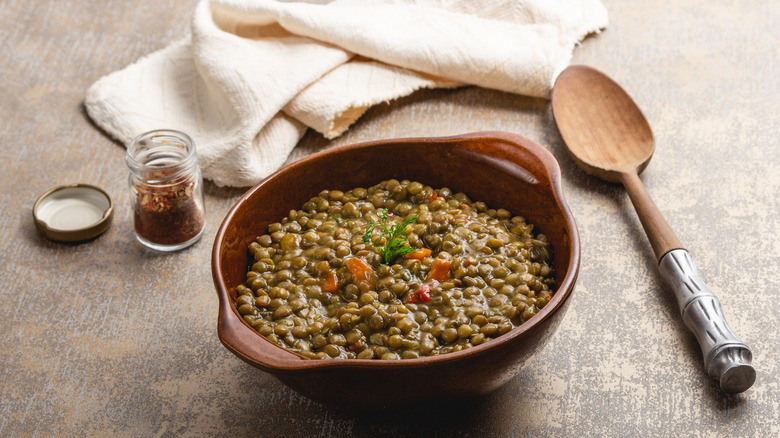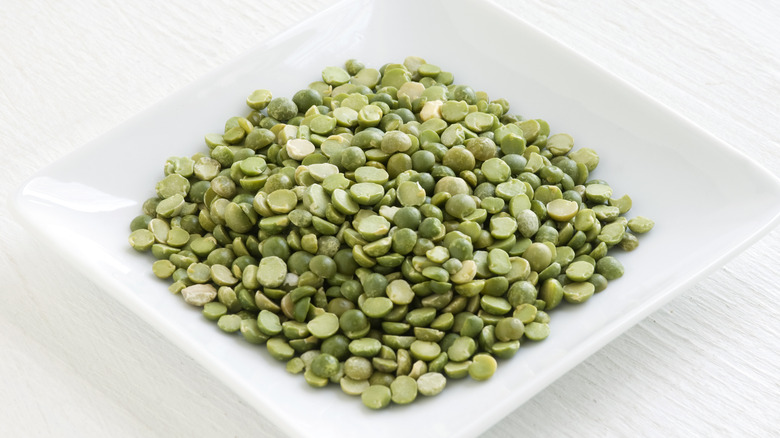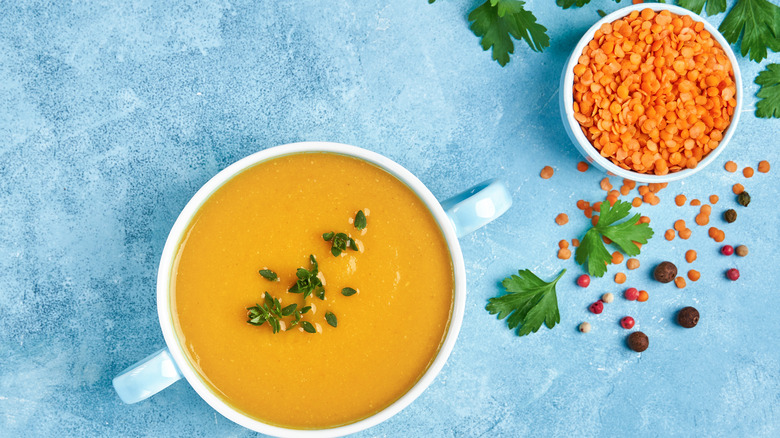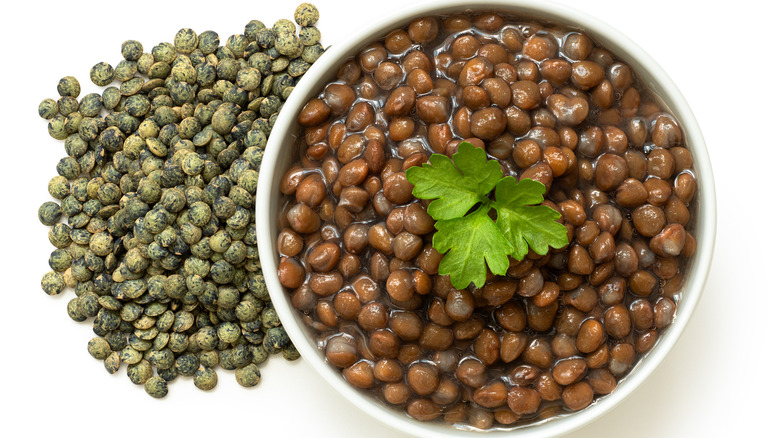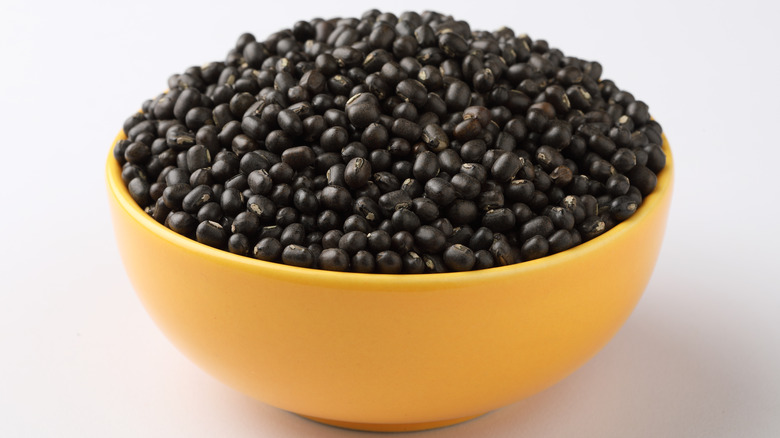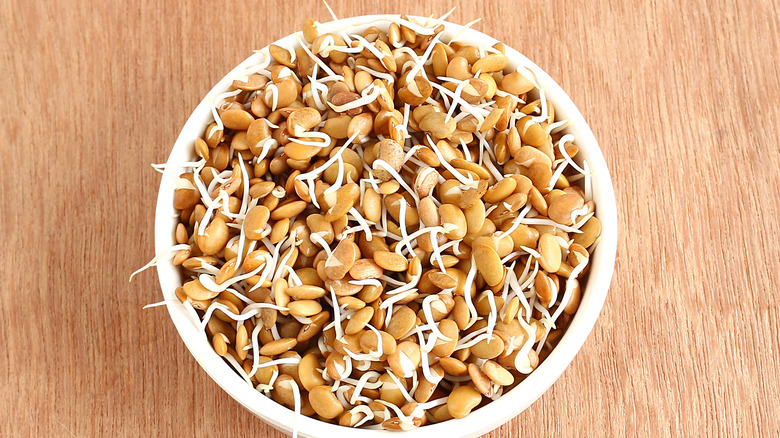7 Types Of Lentils And How To Use Them
Full of nutrients, high in fiber, and packing a protein punch, lentils offer big benefits despite the small package. In addition to being good for you, they have a long shelf life, are easy to prepare, and taste delicious.
Lentils cross cultural boundaries and are consumed all over the world. These legumes are very popular in vegan and vegetarian diets due to their nutritional content and versatility. They are also a highly sought-after crop because it draws nitrogen from the air like a moth to a flame, and into the soil (via the Organic and Non-GMO report). This is great for farmers because they don't need to fork out extra dollars for additional additives and preservatives. It also benefits us, the consumer, because lentils are low in cost.
One of the biggest mistakes people tend to make with lentils is assuming they're all alike. In fact, there are multiple varieties that are available, each offering a different flavor profile, texture, and nutritional benefits. Let this article be your guide to choosing the right type of lentil for your recipe and cooking the powerful legume to perfection.
Brown lentils
Known for their earthy flavor, and creamy texture, brown lentils are ubiquitous and easy to prepare. This makes them an excellent variety for the lentil-challenged. They can range in color from tan to darker brown and have a lens-type shape (via Woodland Foods).
Unlike some other dried legumes, brown lentils don't need to be soaked for long periods of time. They can be cooked immediately, and in less than 30 minutes they'll come out tender while holding their shape.
Brown lentils carry nice nutty notes while being fairly neutral in taste, so let your culinary creativity spark! While other varieties of lentils are excellent accompaniments to curries and soups, brown lentils are hearty and can stand on their own as a star dish or as a side dish to accompany a meat or fish main. There are many great ways to prepare lentils. A quick way to tenderize them is to add 1 cup of lentils, to 2 cups of water. After they become soft, drain the water, and sauté them with your desired oil, spices, and your favorite seasonings. You can also combine them with ziti or rigatoni to prepare pasta e lenticchie, a classic Neapolitan dish. Pasta has a pleasing chewy texture and when mixed with the toothy and creamy texture of brown lentils, it creates a beautiful synergy.
Green lentils
Green lentils have a mild peppery flavor. They can vary in color from green, pale, or spotted green. This variety is known to add a flavor punch and color to soups and salads. Though larger in size than the specialty green Puy lentils, they contain about half the calories (via Plant Based).
It is often said that good things take time, and these delicious legumes are no exception. Unlike brown lentils, the green variety involves a little bit more preparation. You have to soak them for at least a few hours before cooking, ideally overnight to ensure optimum tenderness. Once soaked, boiling them for at least 45 minutes can yield tender lentils without losing the integrity of their mini spaceship-like shape.
Their robust and pleasingly peppery flavor can transform even the simplest salad. After boiling the lentils to your desired texture and draining the water, add in your favorite veggies, and goat cheese and dress with balsamic vinaigrette dressing. Green lentils add substance to the dish, so even the humblest of salads can become a satisfying and fulfilling meal.
If you're entertaining guests or are in the mood for a protein-packed snack, use them instead of chickpeas for a fresh spin on hummus. Once the lentils have cooked down, add the hummus trifecta of tahini, garlic, and lemon juice. Season with parsley, add a touch of olive oil, and let the good times roll.
Red and yellow lentils
Known for their smooth, buttery, and mild flavor, red and yellow lentils are an excellent alternative for those that prefer a softer textured legume. These are the only varieties that are sold as, "split." These cook faster than other lentils because they undergo additional processing into more refined pieces (via Food and Agricultural Association of the UN). The main difference between red and yellow lentils is their slight variation in nutritional content. Red lentils have roughly 30% more potassium, while yellow lentils have 50% more iron (via Planet Based). As far as flavor, red lentils are a bit sweeter.
Unlike black or green lentils, red and yellow lentils have a pleasing mushy texture when cooked. They immerse themselves into dishes nicely, which makes them excellent additions to curries, soups, dips, purées, and stews. An easy way to prepare these legumes is by adding them to your pot when there are 30 minutes of cooking time left. The lentils will immerse themselves nicely into your soup or stew and provide a nice soft textural contrast to the dish, while also adding subtle hints of sweetness.
Puy lentils
Also known as French lentils, Puy lentils are a specialty lentil and are indigenous to the region of Le Puy located in central France. What makes these lentils distinct from the common green lentil is that they're grown in volcanic soil (via Regions of France). This gives the lentil a flinty, earthy, and stronger peppery flavor. It's also rare to find these types of lentils compared to others which makes them more expensive. They may be found in specialty grocery stores. However, shopping for them online may be your best source to find this variety.
Unlike the traditional green lentil, Puy lentils do hold their shape even after boiling for longer periods which makes them an ideal vehicle for salads. An excellent way to prepare this hearty variety is to boil them for about 30 minutes with bay leaves and kombu. The kombu adds flavor but also breaks down phytic acid in the lentils which makes them more digestible (via Bldg 25).
Black lentils
Also called beluga lentils due to their stark resemblance to the prized caviar variety, black lentils are not as common as green or brown because they grow only in cool and dry climates (via Merchant Gourmet). These lens-shaped legumes have a strong earthy flavor and do hold their shape. They're glossy and jet black in color and contain anthocyanins, an antioxidant that's also found in blueberries (via Best Health).
Aside from the health benefits, black lentils are delicious. Just make sure to soak them for a few hours before cooking. This will result in more tenderness and after boiling them for 35-40 minutes, you'll have the perfect toothsome texture. Black lentils have an initial hearty bite but contain a smooth and buttery texture when consumed. They can be used for soups, pureed to make burgers or falafels, and are even a great addition to curries. Black lentils are also excellent when braised (red wine is the liquid of choice for celebrity chef Nigella Lawson).
Horse gram
Horse Gram is the king lentil variety when it comes to protein content. This superfood is fed to race horses, as the name implies, but don't let that deter you from the amazing recipes you can create with the legume (via Net Meds). Horse Gram is widely consumed in India. It's native to the southeast Asian subcontinent and tropical Africa. Not only is horse gram a superfood, but it's a durable food source and drought resistant (via U.S. National Academy of Sciences). You could say it's the perfect doomsday food.
Horse gram has a distinct, earthy, wholemeal flavor that you would find with grains and millets. It's harder, grainer, and dryer than its lentil compadres, so it needs to be soaked overnight, preferably in warm water to tenderize. Due to its texture, it's an excellent lentil to cook with flavorful dishes like curries, soups, and stir-frys. it also provides a pleasant textural contrast and brings out the robust flavors of these types of dishes. You can even sprout them and eat them as a snack. If you're a vegan, vegetarian, or if you want to add more plant-based protein options to your diet, at about 22 grams per 1⁄2 cup serving, horse gram is an excellent option (via MedIndia).

